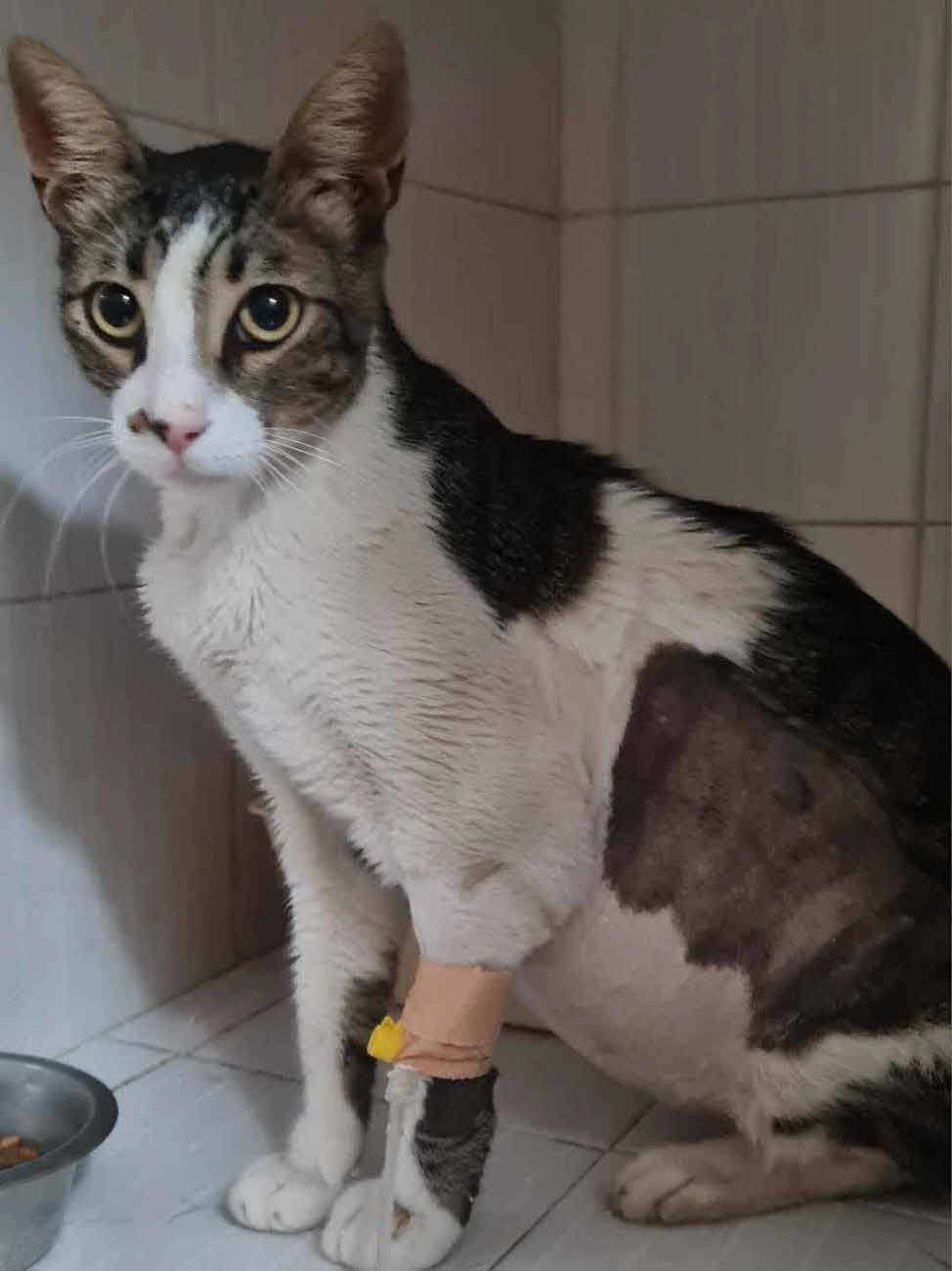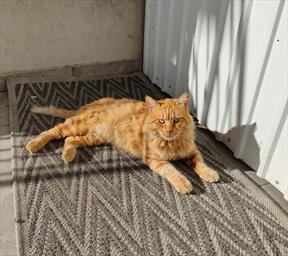Provisional paper on outbreak in Cyprus suggests direct transmission of cat disease
 Listen to this story.
Listen to this story.
Cyprus_FIP_cat

Photo courtesy of Dr. Eva Georgiadi
A cat with feline infectious perotinitis (FIP) in Cyprus shows several signs of the disease, including a swollen belly due to fluid buildup in the lining of the abdomen, an unkempt coat and poor muscle condition.
The first signs of trouble surfaced late last year in Cyprus, an island nation in the eastern Mediterranean famous for its many free-roaming cats. Some veterinarians there began noticing a rise in cases of feline infectious peritonitis (FIP), a fatal cat disease.
The cats were feverish, lethargic, losing weight and didn't want to eat. Some had swollen abdomens; others had tumor-like lesions. Some stumbled about, uncoordinated. Some had inflamed, cloudy or discolored eyes.
FIP usually occurs in cats as a rare response to infection by a common pathogen, feline enteric coronavirus (FECV). The virus is shed in the stool of infected cats, where it can be picked up by other cats. FECV is a subtype of feline coronavirus (FCoV), which is one of hundreds of known coronaviruses, and it doesn't infect people. But among stray cats and those that live with multiple other cats, the virus is ubiquitous. Generally, cats infected with FECV are asymptomatic and remain healthy. But occasionally the virus mutates and causes FIP.
In Cyprus, within the first few months of this year, thousands of cats had been diagnosed. The disease was spreading fast, defying the conventional understanding of how FIP develops.
"That's just not right," Dr. Danielle Gunn-Moore said when she saw this summer that diagnoses on the island had increased 40-fold over the previous year. Gunn-Moore is a professor in feline medicine at The Royal (Dick) School of Veterinary Studies at the University of Edinburgh.
An unpublished paper posted in November to bioRxiv ahead of peer-reviewed publication offers provisional answers to why so many cats were sickened in Cyprus. Based largely on RNA sequencing of samples from scores of FIP-positive cats, the paper authors argue that a coronavirus strain born of separate cat and dog coronaviruses may have combined to bring the fecal shedding and infectivity of regular FECV together with the virulence of a mutated FIP-causing virus in a single pathogen.
"In normal FIP, the FIP virus only rarely gets shared," said Gunn-Moore, an author of the paper. "That is the massive difference with the new outbreak. Everything says this is directly transmissible."
Veterinary researchers asked by the VIN News Service to weigh in on the paper described the evidence as "interesting" and "highly suggestive" but not definitive. They say that more research is needed, which, according to the authors, is well underway.
Meanwhile, veterinarians in Cyprus confronted with FIP cats on an unprecedented scale are putting several promising antiviral treatments to a massive real-world test.
Worries arise on 'cat island'
Dr. Demetris Epaminondas, vice president of the Pancyprian Veterinary Association (PVA), first heard about "worryingly increased cases of FIP" last December from his wife, a veterinarian in clinical practice. Soon, he was fielding similar reports from other practitioners.
A possible surge in a lethal cat disease raises unique concerns on what is sometimes called "cat island," where cats pad, stretch, hunt and sleep everywhere. Revered as holy, large cat colonies live in and near monasteries, where they are cared for by monks. Elsewhere, residents feed and look after neighborhood felines. There is no official estimate of the number of cats on the island.
The PVA sent a questionnaire to the 150 veterinary clinics in Cyprus to try to get a handle on what was happening. Twenty-four clinics in total reported around 500 FIP cases in the first three months of 2023, a tenfold increase over the first three months of the previous year. By April, reports peaked at around 2,000 cases.
The numbers only encompass cats on about half of the island, an area of more than 2,000 square miles. Since the 1970s, Cyprus has been partitioned: The area to the south and west, is under the control of the Republic of Cyprus, home to a Greek Cypriot majority and a member of the European Union. The area to the north is occupied by Turkish military forces and is not under the effective control of the Cyprus government. There have been no official communications about FIP from the north.
Dr. Charalampos Attipa, a veterinary pathologist from Cyprus, noticed the spike in cases in January while he was reviewing test results for Vet Dia Gnosis Ltd., a veterinary diagnostic lab he helped establish in 2021.
No single test exists that can diagnose every case of FIP. Therefore, the diagnosis is often made through a sum of clues from the patient's history, a physical exam and various diagnostic tests, including PCR tests. PCR stands for polymerase chain reaction, a technique that enables users to quickly amplify a small sample of genetic material to study it.
For an FIP diagnosis, the PCR identifies small segments of genetic material from the coronavirus in a sample of fluid from the lining of the abdomen (peritoneum) or lungs (pleura) or from the spine, or from biopsies of tumor-like lesions.
In 2021 and 2022, Vet Dia Gnosis recorded three and four positive PCR tests for cats with FIP in Cyprus. From January through August 2023, there were 165 FIP-related positive PCR tests.
"These are only cats that the owner paid to do the PCR," Attipa said. "It's most likely the top of the iceberg. But we don't really know the iceberg's size. That's the problem."
Attipa, who began working at the University of Edinburgh in April, is the lead author on the preprint paper. He is also a key member of an international collaborative studying the virology, epidemiology and therapeutics of the current outbreak.
Early in the year, Attipa, Epaminondas and others focused on raising awareness among veterinarians and the public. That effort led to some misfires, including a report, picked up by multiple news outlets, that 300,000 cats had died of the disease. Epaminondas said the figure was an unofficial and inaccurate projection by animal welfare organizations. In addition, the PVA's estimate of 8,000 cats infected by mid-July was misreported by the Associated Press as 8,000 dead. There is no official estimated death toll.
Cases confirmed by PCR began to drop in April, but that may not be cause for celebration.
"At first, people didn't know what this disease was, so they were bringing animals to the vet to get the diagnosis," Epaminondas said. But with growing awareness, cat owners and caregivers knew about the FIP surge and the clinical signs, like the swollen abdomen present in one form of the disease. "Because of the fact that they can find black market treatments, they don't want to give the money to properly diagnose the disease," he said.
Cyprus_map_final

In recent years, antiviral compounds have shown remarkable promise in reversing the course of FIP. However, those compounds are not approved for veterinary use in many countries. As a result, a black market in antivirals, most made in China, is thriving, fueled by desperate cat owners who treat their pets on their own. A 2021 study of cats given unlicensed antivirals in the U.S. found survival rates of 80% and better.
PCR tests ticked up again in August, which might be due to the Cypriot government approving the veterinary use of molnupiravir, an antiviral used for treating Covid-19 in humans. Cats must be PCR-positive in order for their owners or caregivers to obtain a prescription.
Case counts for most of the second half of the year, based on surveys of clinics, should be available soon, Epaminondas said.
Dr. J. Scott Weese, an infectious diseases veterinarian at the University of Guelph's Ontario Veterinary College, said in an email to VIN News that the epidemiology of the outbreak isn't well described, adding that it's "a common problem with field studies where info is sparse and often anecdotal."
The number of PCR-confirmed cases — 165 — is very small, Weese said, especially for a country with many feral cats. He also said the diagnosis rates based on questionnaires raise a question: Are there more diagnoses because there's a marked increase in disease, a marked increase in testing or both?
"It seems like there's been an increase in FIP on Cyprus. How much is hard to say," he said. "When you get more discussion and awareness, you get more diagnoses of endemic disease that may have been there all the time, just ignored. Often times, these are combination situations where there's a true increase or a small local cluster, but increased discussion and testing leads to overestimation of the degree of change."
He added: "I'm not discounting that this was a true outbreak or that this is a concerning new strain. We just don't know (or at least I don't). This paper shows that we need to look more."
Introducing FCoV-23
Snapshot of complex disease
Understanding how the new strain is behaving differently than what some researchers are calling "traditional FIP" requires a closer look at how FECV leads to FIP.
For reasons that are not fully understood, sometimes the FECV mutates inside the cat. The changes enable it to escape enteric cells and infect a basic cell of the immune system, the macrophage. This macrophage-infecting virus is known as the FIP virus or FIPV. It can travel all over the body now, "trashing the place" in Gunn-Moore's words, causing potentially lethal inflammation.
Once the coronavirus is FIPV, it has two important qualities: First, it is no longer an enteric virus so it can only very rarely return to the intestines to be shed as FIPV in feces. Second, the FIPV has a gene sequence that is unique to that cat.
FCoV-23, as the new strain has been named, appears to break both those patterns. Gunn-Moore said it is thriving in the intestines of Cyprus cats. In addition, based on RNA sequencing from PCR samples, the virus in many of the cats had the same genetic sequence. The genetic sequencing was performed by researchers at The Roslin Institute, an animal science research center at the University of Edinburgh.
Gunn-Moore had several early hypotheses about what might be driving the outbreak, but the genetic analysis points to her leading theory — that a pantropic canine coronavirus had combined with a feline enteric coronavirus. Pantropic viruses can spread to different tissues in the body, a trait that would enable the FCoV-23 to reach other organs and nerves, as well as continue thriving in the gut.
"I think a dog came to Cyprus, pooped on the floor. A cat who already had FECV then got the dog's feces on its feet and licked its paws and had both viruses," she said. "And these viruses, that's what they do, they recombine; they're party animals. They get together, and they go, 'Oh, hey, do you want a bit of this? I'll give you a bit of that?' "
Gunn-Moore added that more work is planned to cement the case for direct transmission.
"We're currently running experiments sequencing the virus from feces because we need to sequence the virus and show it's the same sequence as in the blood," she explained.
Dr. Brian Murphy, a veterinary pathologist and FIP researcher at the University of California, Davis, School of Veterinary Medicine, said a recombinant feline/canine coronavirus like that described in the Cyprus paper has been identified before, including by a team at Washington State University's School of Veterinary Medicine in the 1970s.
"This is a replication of that, but this is a highly more virulent form of the virus," Murphy said, based on the evidence so far. He welcomes researchers' plans for additional genetic analysis, and he suggests more investigation.
"Just sequencing enteric corona, or the gut-derived virus, is compelling, but it's not proof," he said. "It wouldn't be a bad experiment to take fecal material containing the enteric-derived virus, infect cats, and then when they get sick, rescue those cats with antiviral therapy. That would be a good proof of transmission of the virulent form of the virus."
Murphy conceded that this sort of test on a companion animal is essentially forbidden in Europe and would likely be highly controversial. "I think most people probably on the paper are going to disagree with me," he said. "But I think that it can be done ethically because we do have high-quality and highly effective drugs."
Dr. Maria Lyraki, an internal medicine specialist in Athens, Greece, who is coordinating treatment protocols with veterinarians in Cyprus and is an author on the paper, said Murphy is right that the experiment would be proof, although some of the infected cats may not get sick if they mount an adequate immune response.
"But this is something that ethically, we would not be willing to pursue," she said.
Thousands of sick cats
If the Cyprus outbreak had occurred 10 years ago, countless cats likely would have died because, until recently, there was no known way to stop the course of the disease.
Antivirals have changed that picture.
Two promising products are remdesivir, made by the pharmaceutical company Gilead to treat Covid-19 in humans; and a related compound, GS-441524. GS, as it is called for short, was shown to be effective in reversing FIP in cats in an infection study at the University of California, Davis, in 2018.
Gilead has not licensed GS-441524 to be developed as a veterinary drug. Veterinarians in the United State can use remdesivir on an extralabel basis. It is not an approved veterinary drug in Canada and in some European countries.
However, since August, through a special dispensation, Cyprus veterinarians have been able to import compounded versions of GS and remdesivir produced by Bova, a veterinary pharmaceutical company in the United Kingdom and Australia, under guidance from the U.K.'s Veterinary Medicines Directorate.
GS and remdesivir "are the first line of the drugs we use because we have the most literature on them," Lyraki said. "But they are really expensive … which is really difficult, especially for such a large number of stray cats."
It can cost between €3,000 and €7,000 (between US$3,250 and $7,580) to treat a single cat with these drugs, according to Epaminondas.
"We contacted people from all over the world that are treating FIP cases," Lyraki said. "And specialists advised that they have been using molnupiravir. We have some published literature about this drug and a lot of anecdotal discussions between FIP specialists around the world that this is working."
The government's decision to allow veterinary use of molnupiravir has made a huge difference.
"It actually works quite well," Lyraki said. Initially, boxes of molnupiravir were donated by the PVA to combat the outbreak. They were made available at an exceptionally low cost of around €100 ($108) per cat — a substantial savings. The real cost of the drug is a lot more than that but still significantly cheaper than GS.
The molnupiravir fix, however, won't last. Merck Sharp and Dohme B.V., which market the antiviral as Lagevrio, will stop producing it for Europe next year following the European Medicines Agency decision earlier this year not to back marketing authorization for molnupiravir based on its finding that the antiviral's benefit in treating Covid in adults has not been demonstrated.
"We are now working on finding alternatives," Lyraki said.
Containing the spread
Cyprus_FIP_cat3

Photo by Dr. Charalampos Attipa
A healthy free-roaming cat lounges outside a bakery in Pafos, Cyprus. Stray cats are everywhere on the island — though no one knows how many there are. As part of the response to the FIP outbreak, the Pancyprian Veterinary Association is launching an initiative with ThePetzApp to enlist cat owners and caregivers in Cyprus to provide counts of the number of cats in their homes or in the stray colonies they look after.
Beyond the immediate situation in Cyprus are worries that the strain could spread to other countries or that it is already in other countries, from which it traveled to Cyprus, as yet unrecognized.
The new strain was confirmed in a cat that was imported to the U.K. from Cyprus in August. That cat has been quarantined and is responding to treatment.
Keeping cats contained on the island may be a challenge. Cyprus is the site of many "cat rescue" efforts. Strays are regularly gathered up and taken elsewhere in Europe to be rehomed. There are no regulations regarding the export of cats from Cyprus, Epaminondas said.
However, veterinarians like Lyraki are encouraging rescue groups to exercise caution. "Our expert team has issued the recommendation to test cats prior to traveling outside of Cyprus and to export only FCoV antibody negative cats,'' Dr Lyraki said. Once the cats arrive at their destination, they should be quarantined for three weeks, then retested for antibodies "until the outbreak is under control and the number of cats affected is significantly reduced."
Meanwhile, Greece, which has its own large stray population, has also seen a rise in FIP cases, according to Lyraki.
"We believe it's a matter of time for this outbreak to spread to Greece because Greece and Cyprus are really, really close culturally, geopolitically. There's a lot of exchange and traveling between them," she said. "So that's something that we are actively monitoring."
This story incorrectly stated that remdesivir could not be used by veterinarians in the U.S. It has been corrected to reflect that extralabel use has been allowed since October 2020.